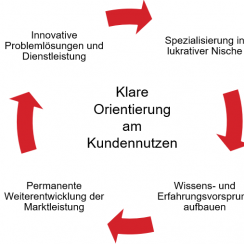Swiss companies are often positioned in a niche and tend to thrive in this environment. This can be a competitive advantage, provided that the success characteristics of this niche can be found in a comparable form in the targeted foreign market. The existence of this condition in new markets should be examined: Is the niche large enough, is it sufficiently differentiated from other offers, are the central characteristics of your product or service equally relevant for the customers of your foreign target market? A different communication strategy may be required than that in the mature home market, because your company will actually be starting from scratch in the new foreign market.
First gain a foothold in the domestic market, then gradually expand
In general it can be said that a lack of market success in Switzerland or the high intensity of competition in Switzerland are unsuitable reasons for entering new international markets. As a rule, it is worth building up sufficient stature in your home market and using this (sales, cash flow and experience) as a basis for entering new markets. Market development is complex everywhere, the competitive environment in most markets is very intensive and market success is always uncertain. “As you know, there are no markets that are easy to conquer, neither at home nor elsewhere.
Clear customer focus is likely to lead to success
A solid and valid information and data basis regarding your customers’ requirements is therefore indispensable for every new market. The experience of one market can prove to be very different in a neighbouring market. It is not only information on the documentable current behavior of customers that is import here, but also information on the implicit requirements, concerns, unsolved problems and hoped-for benefits from the purchase of products or services. This more comprehensive customer profile model is based on “jobs, pains and gains”. These insights form the basis for a market-specific customer offering (value proposition), which is then ideally assessed directly with customers with small, agile market tests. In this way you can ensure that the unique selling propositions that have been well received in your home market also promise success in the respective new target market.
Niche specialization is not enough
Positioning yourself as a company in a niche market is clearly an advantage, but it shouldn’t be your sole strategy for success. In addition to ascertaining customer requirements, gaining an edge with regard to knowledge and experience is essential.
“Understanding in sufficient depth which elements of your offering have what value for which customers in which foreign market is crucial for success.” Alberto Silini, Head of Consultation, Switzerland Global Enterprise
Agile development of the offering to stand out from the crowd
Based on the findings, the market-specific offering (value proposition) can be constantly further developed and, ideally, reviewed directly with customers in small, agile market tests. This enables you to ensure that unique selling propositions which were well received in your domestic market also promise success in the respective new target market. Companies that offer innovative solutions to problems and develop themselves and their products thus find it easier to stand out from the crowd and occupy a niche (see the customer view model in the image gallery).
Initial recommendations for action
- For each foreign market, re-examine which element of your offering corresponds to which value perception of foreign customers.
-
Explore not only the obvious product and function-related requirements of your customers, but also the underlying motives and needs. There are several providers of method that make this analysis easier for you. For example, outline an appropriate value proposition canvas for all your important customers or customer groups in a specific foreign market and sector. Be sure to consider the cultural conditions that can have a significant influence on customer behavior.
- Be sure not to forget the cultural conditions that can have a significant influence on customer behavior.
In the following article you will find useful tips for determining the right price strategy.
The complete guide on how to start exporting successfully can be found here:
“Export Compact” - Getting Started with Internationalization








